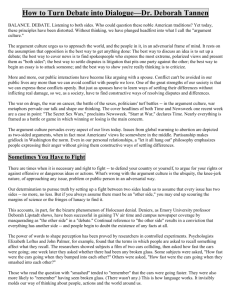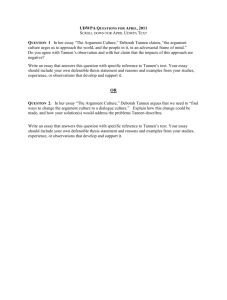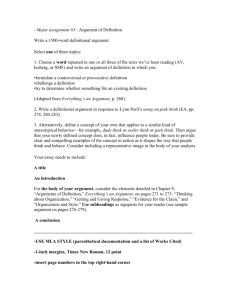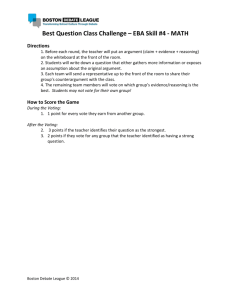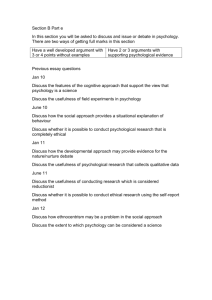Deborah Tannen
advertisement
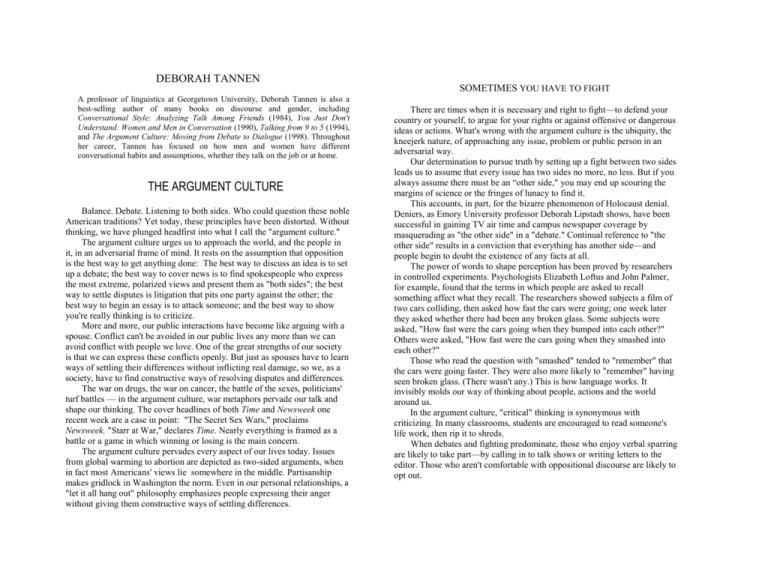
DEBORAH TANNEN A professor of linguistics at Georgetown University, Deborah Tannen is also a best-selling author of many books on discourse and gender, including Conversational Style: Analyzing Talk Among Friends (1984), You Just Don't Understand: Women and Men in Conversation (1990), Talking from 9 to 5 (1994), and The Argument Culture: Moving from Debate to Dialogue (1998). Throughout her career, Tannen has focused on how men and women have different conversational habits and assumptions, whether they talk on the job or at home. THE ARGUMENT CULTURE Balance. Debate. Listening to both sides. Who could question these noble American traditions? Yet today, these principles have been distorted. Without thinking, we have plunged headfirst into what I call the "argument culture." The argument culture urges us to approach the world, and the people in it, in an adversarial frame of mind. It rests on the assumption that opposition is the best way to get anything done: The best way to discuss an idea is to set up a debate; the best way to cover news is to find spokespeople who express the most extreme, polarized views and present them as "both sides"; the best way to settle disputes is litigation that pits one party against the other; the best way to begin an essay is to attack someone; and the best way to show you're really thinking is to criticize. More and more, our public interactions have become like arguing with a spouse. Conflict can't be avoided in our public lives any more than we can avoid conflict with people we love. One of the great strengths of our society is that we can express these conflicts openly. But just as spouses have to learn ways of settling their differences without inflicting real damage, so we, as a society, have to find constructive ways of resolving disputes and differences. The war on drugs, the war on cancer, the battle of the sexes, politicians' turf battles — in the argument culture, war metaphors pervade our talk and shape our thinking. The cover headlines of both Time and Newsweek one recent week are a case in point: "The Secret Sex Wars," proclaims Newsweek. "Starr at War," declares Time. Nearly everything is framed as a battle or a game in which winning or losing is the main concern. The argument culture pervades every aspect of our lives today. Issues from global warming to abortion are depicted as two-sided arguments, when in fact most Americans' views lie somewhere in the middle. Partisanship makes gridlock in Washington the norm. Even in our personal relationships, a "let it all hang out" philosophy emphasizes people expressing their anger without giving them constructive ways of settling differences. SOMETIMES YOU HAVE TO FIGHT There are times when it is necessary and right to fight—to defend your country or yourself, to argue for your rights or against offensive or dangerous ideas or actions. What's wrong with the argument culture is the ubiquity, the kneejerk nature, of approaching any issue, problem or public person in an adversarial way. Our determination to pursue truth by setting up a fight between two sides leads us to assume that every issue has two sides no more, no less. But if you always assume there must be an “other side," you may end up scouring the margins of science or the fringes of lunacy to find it. This accounts, in part, for the bizarre phenomenon of Holocaust denial. Deniers, as Emory University professor Deborah Lipstadt shows, have been successful in gaining TV air time and campus newspaper coverage by masquerading as "the other side" in a "debate." Continual reference to "the other side" results in a conviction that everything has another side—and people begin to doubt the existence of any facts at all. The power of words to shape perception has been proved by researchers in controlled experiments. Psychologists Elizabeth Loftus and John Palmer, for example, found that the terms in which people are asked to recall something affect what they recall. The researchers showed subjects a film of two cars colliding, then asked how fast the cars were going; one week later they asked whether there had been any broken glass. Some subjects were asked, "How fast were the cars going when they bumped into each other?" Others were asked, "How fast were the cars going when they smashed into each other?" Those who read the question with "smashed" tended to "remember" that the cars were going faster. They were also more likely to "remember" having seen broken glass. (There wasn't any.) This is how language works. It invisibly molds our way of thinking about people, actions and the world around us. In the argument culture, "critical" thinking is synonymous with criticizing. In many classrooms, students are encouraged to read someone's life work, then rip it to shreds. When debates and fighting predominate, those who enjoy verbal sparring are likely to take part—by calling in to talk shows or writing letters to the editor. Those who aren't comfortable with oppositional discourse are likely to opt out. HOW HIGH-TECH COMMUNICATION PULLS US APART One of the most effective ways to defuse antagonism between two groups is to provide a forum for individuals from those groups to get to know each other personally. What is happening in our lives, however, is just the opposite. More and more of our communication is not face to face, and not with people we know. The proliferation and increasing portability of technology isolates people in a bubble. Along with the voices of family members and friends, phone lines bring into our homes the annoying voices of solicitors who want to sell something—generally at dinnertime. (My father-in-law startles phone solicitors by saying, "We're eating dinner, but I’ll call you back. What's your home phone number?” To the non-plused caller, he explains, "Well, you're calling me at home; I thought I'd call you at home, too.") It is common for families to have more than one TV, so the adults can watch what they like in one room and the kids can watch their choice in another—or maybe each child has a private TV. E-mail, and now the Internet, are creating networks of human connection unthinkable even a few years ago. Though e-mail has enhanced communication with family and friends, it also ratchets up the anonymity of both sender and receiver, resulting in stranger-to-stranger "flaming." "Road rage" shows how dangerous the argument culture—and especially today's technologically enhanced aggression—can be. Two men who engage in a shouting match may not come to blows, but if they express their anger while driving down a public highway, the risk to themselves and others soars. THE ARGUMENT CULTURE SHAPES WHO WE ARE The argument culture has a defining impact on our lives and on our culture. It makes us distort facts, as in the Nancy Kerrigan-Tonya Harding story. After the original attack on Kerrigan's knee, news stories focused on the rivalry between the two skaters instead of portraying Kerrigan as the victim of an attack. Just last month, Time magazine called the event a "contretemps" between Kerrigan and Harding. And a recent joint TV interview of the two skaters reinforced that skewed image by putting the two on equal footing, rather than as victim and accused. It makes us waste valuable time, as in the case of scientist Robert Gallo, who co-discovered the AIDS virus. Gallo was the object of a groundless four-year investigation into allegations he had stolen the virus from another scientist. He was ultimately exonerated, but the toll was enormous. Never mind that, in his words, "These were the most painful and horrible years of my life." Gallo spent four years fighting accusations instead of fighting AIDS. It limits our thinking. Headlines are intentionally devised to attract attention, but the language of extremes actually shapes, and misshapes, the way we think about things. Military metaphors train us to think about, and see, everything in terms of fighting, conflict and war. Adversarial rhetoric is a kind of verbal inflation—a rhetorical boy-who-cried-wolf. It encourages us to lie. If you fight to win, the temptation is great to deny facts that support your opponent's views and say only what supports your side. It encourages people to misrepresent and, in the extreme, to lie. END THE ARGUMENT CULTURE BY LOOKING AT ALL SIDES How can we overcome our classically American habit of seeing issues in absolutes? We must expand our notion of "debate" to include more dialogue. To do this, we can make special efforts not to think in twos. Mary Catherine Bateson, an anthropologist at Virginia's George Mason University, makes a point of having her class compare three cultures, not two. Then, students are more likely to think about each on its own terms, rather than as opposites. In the public arena, television and radio producers can try to avoid, whenever possible, structuring public discussions as debates. This means avoiding the format of having two guests discuss an issue. Invite three guests—or one. Perhaps it is time to re-examine the assumption that audiences always prefer a fight. Instead of asking, "What's the other side?" we might ask, "What are the other sides?" Instead of insisting on hearing "both sides," let's insist on hearing "all sides." We need to find metaphors other than sports and war. Smashing heads does not open minds. We need to use our imaginations and ingenuity to find different ways to seek truth and gain knowledge through intellectual interchange, and add them to our arsenal—or, should I say, to the ingredients for our stew. It will take creativity for each of us to find ways to change the argument culture to a dialogue culture. It's an effort we have to make, because our public and private lives are at stake.
